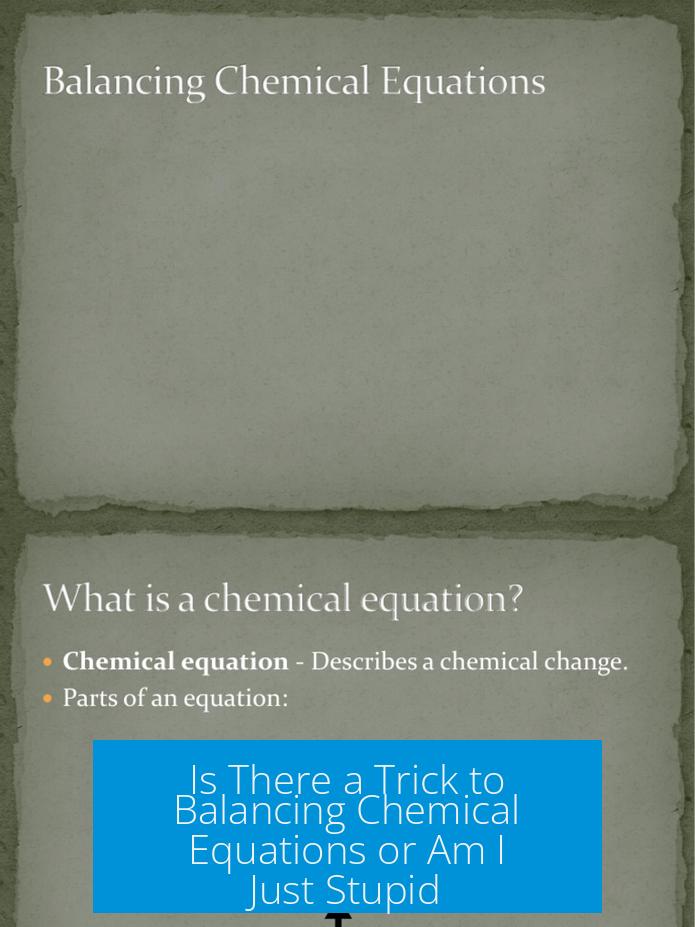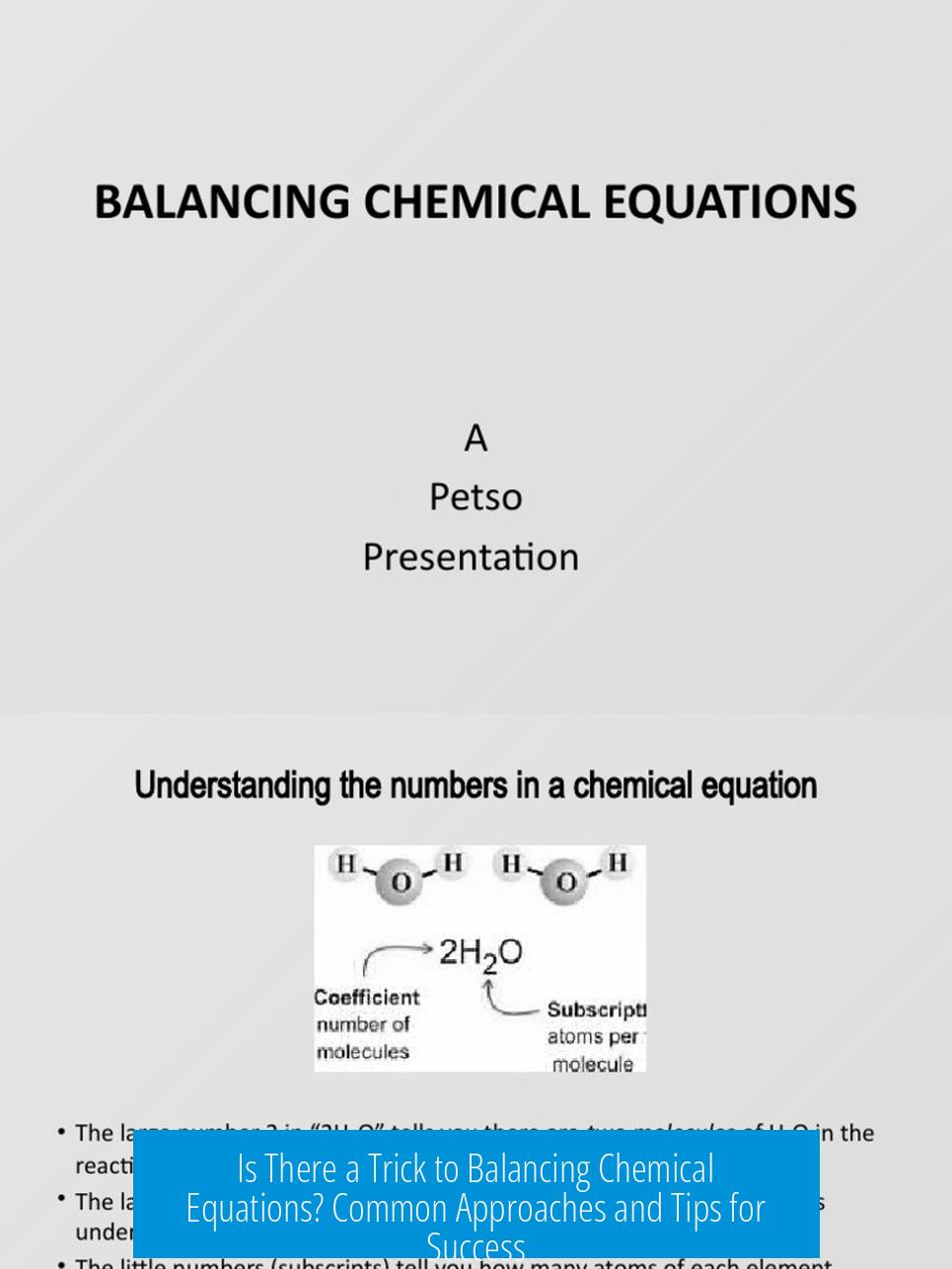Is There a Trick to Balancing Chemical Equations or Am I Just Stupid?

Balancing chemical equations requires patience and a systematic approach rather than a simple trick. It involves ensuring the number of atoms of each element is equal on both sides of a reaction. Many find it challenging at first, but it’s not a reflection of intelligence. Instead, balancing equations is often best handled step-by-step and with practice.
Understanding the Purpose of Balancing Equations
Chemical equations must obey the Law of Conservation of Mass. This means the atoms present in the reactants must match those in the products. Balancing an equation is the process of adjusting coefficients—the numbers placed before compounds—to satisfy this rule.
This process ensures correct stoichiometry, which chemists rely on for quantitative predictions in reactions.
Common Approaches: Trial and Error
The most accessible method for beginners is trial and error. This involves adjusting coefficients, checking atom counts, and repeating until balanced. While it may seem tedious, it works well for simple reactions.
Stepwise Example: Combustion of Propanol
Consider the combustion reaction of propanol (C3H7OH) with oxygen:
(A) C3H7OH + (B) O2 → (C) CO2 + (D) H2O
- Start by setting coefficient (A) to 1, fixing the molecule with complex composition.
- Balance carbon atoms: There are 3 carbons in C3H7OH, so set coefficient (C) to 3 for CO2.
- Balance hydrogen atoms: 8 hydrogens in propanol lead to 4 water molecules (since H2O has 2 hydrogens each), so (D) = 4.
- Balance oxygen last: Count oxygen atoms on the right (3×2 in CO2 + 4×1 in H2O = 10). On the left, one oxygen is in propanol, so 9 left to be balanced by O2 molecules (each O2 has 2 oxygen atoms). This gives (B) = 4.5.
- Remove fractional coefficients by multiplying all by 2:
(2) C3H7OH + (9) O2 → (6) CO2 + (8) H2O
This method involves focusing on one element at a time, starting with those appearing once per side, leaving elements appearing multiple times (like oxygen) for last.
Balancing Polyatomic Ions as Units
In some reactions, polyatomic ions remain intact on both sides. This offers a shortcut by treating the entire ion as a single entity instead of balancing constituent atoms separately.
Example:
Ca(NO3)2 + Na3PO4 → Ca3(PO4)2 + NaNO3
- Instead of balancing nitrogen (N), oxygen (O), and phosphorus (P) individually, treat nitrate (NO3)^- and phosphate (PO4)^3- as units.
- Balance calcium, sodium, nitrate, and phosphate groups stepwise.
This reduces complexity, especially when ions stay unchanged chemically yet appear as part of different compounds.
Is There a “Trick” Beyond Trial and Error?
Short answer: No universal shortcut exists. The apparent trick is to slow down, focus on one element or group at a time, and practice. Many learners mistakenly try to balance all elements at once, which complicates the task.
Trial and error suits simpler problems but can be impractical with complex reactions that have many elements or compounds.
Linear Algebra: A Systematic Alternative
For more complex equations, linear algebra offers a foolproof method. Each unknown coefficient becomes a variable, and atom-balancing leads to a system of linear equations.
This system can be represented in matrix form and solved using standard algebraic techniques. This approach guarantees a solution if one exists and handles complexity better than trial and error.
However, linear algebra requires some mathematical background and can reveal “corner cases” where special attention is necessary.
For detailed treatment, see research such as the paper “Balancing Chemical Equations Using Linear Algebra”.
Helpful Tips for Effective Balancing
- Start Simple: Balance elements appearing once on each side first.
- Save Oxygen and Hydrogen Last: These often appear in multiple compounds.
- Handle Polyatomic Ions as Units: If ions remain intact, balance them as single entities.
- Avoid Guessing Too Much at Once: Take one step at a time for clarity.
- Practice Regularly: Builds intuition for recognizing common patterns.
- Use Technology: Apps like ReactionMate can assist in balancing complex equations.
Community Insights and Attitudes
Struggling with balancing equations is common and normal. Many students question their abilities, but difficulty does not imply a lack of intelligence.
Many chemists and educators emphasize patience and systematic practice over shortcuts. Confidence improves when users learn to approach problems methodically and realize that difficulty is part of mastering chemistry.
Tools and Apps
Technology aids in balancing equations. Apps such as ReactionMate allow users to input unbalanced reactions and receive balanced versions. These tools serve as learning aids and help verify manual work.
While helpful, relying solely on apps is not recommended. Understanding the principles behind balancing strengthens foundational chemistry knowledge.
Key Takeaways
- Balancing equations requires adjusting coefficients to equalize atoms across reactants and products.
- No universal shortcut exists; the best strategy involves a patient, stepwise approach.
- Trial and error works well for simple cases but is limited for complex reactions.
- Treat polyatomic ions as whole units when possible to simplify balancing.
- Linear algebra provides a systematic, foolproof method but needs some mathematical skills.
- Practicing regularly and using available tools can build confidence and skill.
- Struggling with balancing does not reflect any lack of ability or intelligence.
Why do I struggle with balancing chemical equations? Am I bad at it?
No, struggling is normal. Balancing equations takes practice. Many people try to do too much at once. Slowing down and working one step at a time helps. It’s about getting used to the process, not intelligence.
Is there a simple trick to balancing all chemical equations?
There’s no universal trick. Trial and error is common for simple cases. A useful tip is to balance elements that appear once first, usually leaving oxygen or polyatomic ions for last. The method works best stepwise and with patience.
How can I handle polyatomic ions when balancing equations?
Treat polyatomic ions as single units instead of separate atoms. If the ion stays intact, balance it as one piece. This simplifies the process by reducing the number of things you track separately.
Can linear algebra really help balance equations?
Yes, linear algebra solves balancing systematically by treating it as an equation system. It works for complex reactions but can be tricky. Some special cases still cause issues, so understanding basics first is key.
Are there tools to help me balance equations?
Yes, apps and online tools exist to make balancing easier. They automate trial and error or use math methods behind the scenes. Using these can save time and reduce frustration while you learn.





Leave a Comment